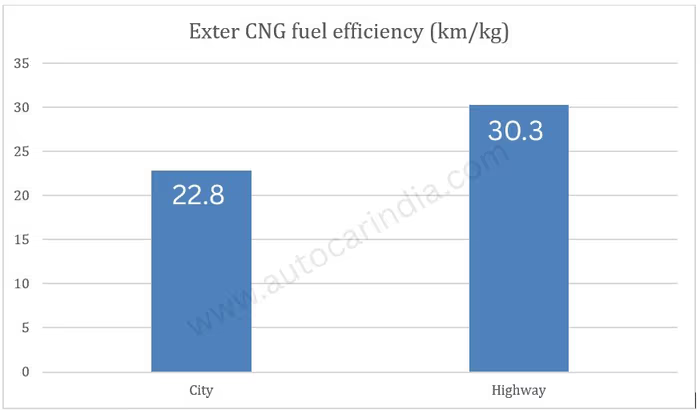We find out if the Exter Hy-CNG Duo can deliver the ARAI-claimed fuel economy of 27.1km/kg.
Like the Tata Punch iCNG, even the Hyundai Exter has introduced this sub-compact SUV with a twin compressed natural gas (CNG) tank setup. We put the Hyundai Exter Hy-CNG Duo through our test to find out whether it can deliver its claimed efficiency of 27.1km/kg in the real world.
- ARAI claimed efficiency is 27.1km/kg
- Top-spec iCNG weighs 1093kg
- Priced between Rs 7.51 lakh and Rs 9.53 lakh
Hyundai Exter CNG fuel efficiency tested
Real world range is very close to its claimed figure
The Hyundai Exter Hy-CNG Duo is powered by a 4-cylinder 1197cc engine which produces 69hp and 95Nm of torque when running on CNG. Like the Punch iCNG, it is mated to a five-speed manual transmission. In our real world tests, the Exter Hy-CNG Duo returned 22.8km/kg in the city and 30.3km/kg on the highway, averaging an impressive 26.6km/kg, very close to its ARAI claimed efficiency figure of 27.1km/kg.

The Exter’s shorter gearing and smoother engine with ample low-end torque requires fewer gearshifts while in traffic, thereby improving its city fuel efficiency. On the highway though, the Exter Hy-CNG Duo’s engine spins at a rather high 3300rpm while cruising at 100kph in fifth gear, which hampers its highway fuel efficiency.
Autocar India’s fuel efficiency testing
CNG tanks are trickier to fill, and there are several variables, particularly ambient temperature and pump pressure. So, we didn’t opt for our standard tankful-to-tankful methodology. For our real-world test, we emptied their CNG tanks and filled each of them with 2 kilograms of CNG. Then, we drove them within urban confines till they ran out of gas. We repeated the process for the highway test. Throughout the drive, these cars were driven in CNG mode only.
Tyre pressures were maintained based on the manufacturer’s recommendation. These cars were driven on fixed city and highway loops in and around Navi Mumbai, maintaining certain average speeds. Throughout the tests, there was only one person in the car who ran the aircon and other electricals, such as the audio system, indicators and wipers, when required – just like a regular user would. Periodic driver swaps further neutralise variations in driver patterns. We take pride in our testing data, which isn’t merely consistent but also gives users an accurate indication of what they can expect in the real world.
Also See:

